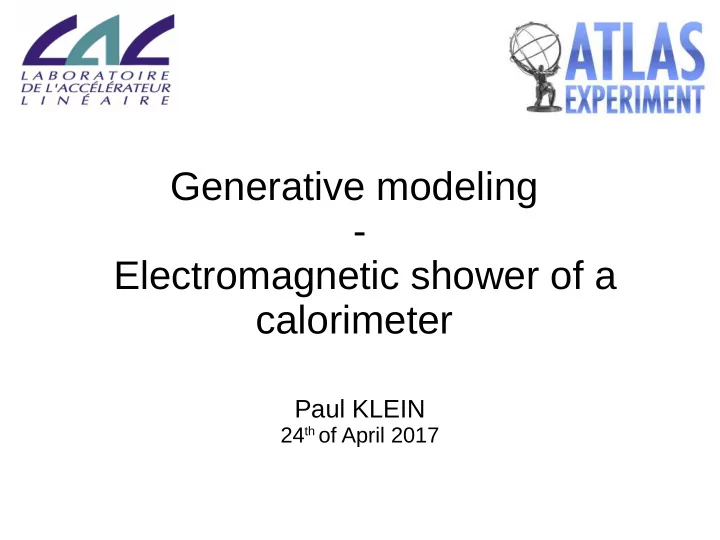

Generative modeling - Electromagnetic shower of a calorimeter Paul KLEIN 24 th of April 2017
Issue : Simulations (Geant4 Package) are time consuming and CPU intensive REAL LIFE SIMULATION VS ~ O(10 9 ) events/year ~ O(0,1) event/min ~ O(1000) events/min 2
SECTIONS 1) Specifications, Dataset, Simplification of the problem 2) Generative Adversarial Networks (GAN) 3) A GAN example : Jupyter Notebook 4) Some results : comparisons between Real/Generated simulations 5) Work in progress 3 24th of April 2017 SystML Meeting
1) Specifications, Dataset EM shower in the Electromagnetic Calorimeter The calorimeter is represented as the brown . area on the scheme rgy ( → meas asure res part article energ energy 4 ) deposits in the cell of the calorimeter
1) Specifications, Dataset CONTEXT : Measurements in the Calorimeter Direction of the particle The calorimeter is represented as the brown Structure of the barrel electromagnetic calorimeter . area on the scheme rgy ( → meas asure res part article energ energy 5 ) deposits in the cell of the calorimeter
1) Specifications, Dataset Simulation of EM showers : Position of the problem 1 incident particle → 10 9 particles in the shower → have to generate 10*10 9 variables in total in the Simulation HUGE COMPUTATIONS ! USE GANs to generate fastly EM showers (no scientific expertise, inexpensive to run once they have been trained) 6
1) Specifications, Dataset CONTEXT :Simulation Dataset ● Monte-Carlo data (MC) ● Single-photon Particle Gun ● ~ 44K events ● For each event, we have the energy per cell of the calorimeter ● We only focus on a cluster of 89 cells of the calorimeter for each event ● Select a calorimeter region to avoid edge effects TO SUM UP, we have 89 floats for each event corresponding to the simulated energy deposits in the cluster 7
2) Generative Adversarial Networks (GAN) Architecture of a GAN s Attached label 1 ŝ = G(z) z ~ {N(0,1)} m Attached label -1 8
2) Generative Adversarial Networks (GAN) How could we train a GAN ? Training a GAN is really based on the idea that we . alternatively train the Discriminator and the Generator Train the Discriminator Classic Consider the network BACKPROPAGATION Train the Generator ? {Generator + Discriminator}, and freeze Discriminator weights 9
2) Generative Adversarial Networks (GAN) Choice of the loss : Wasserstein distance Martin Arjovsky, Soumith Chintala, and Léon Bottou. Wasserstein GAN / arXiv:1701,07875v1 [stat,ML] Use Wasserstein distance to calculate the loss instead of Jensen- Shannon or Kullback Leibler divergence Discriminator will have a continuous and almost everywhere differentiable wasserstein distance. 10
3) A GAN Example : Jupyter Notebook Formal WGAN procedure Discriminator training Generator training 11
4) Comparison between simulated and generated data Reminder about calorimeter geometry Calorimeter is organised in 4 layers. Each of them has a special geometry of cell. 1) Pre-sampler 2) Strip 3) Middle 4) Back 12
4) Comparison between simulated and generated data Mean cells intensities (Middle) GENERATED DATA REAL DATA 13
4) Comparison between simulated and generated data Mean cells intensities (Strip) 10 3 True averaged Pixels intensities - Strip REAL DATA 1 0 10 2 0 5 10 15 20 10 1 10 3 Generated averaged Pixels intensities - Strip GENERATED DATA 1 0 10 2 0 5 10 15 20 14 10 1
4) Comparison between simulated and generated data Mean cells intensities (Back) REAL DATA GENERATED DATA 15
4) Comparison between simulated and generated data Mean cells intensities (Pre-Sampler) REAL DATA GENERATED DATA 16
4) Comparison between simulated and generated data Averaged Eta per layer 17
4) Comparison between simulated and generated data Averaged Phi per layer 18
4) Comparison between simulated and generated data RMS (for eta) – per layer 19
4) Comparison between simulated and generated data Total Energy per event Here we « enforced » the discriminator to learn several parameters such as mean energy of the event 20 All histograms have been normed
4) Comparison between simulated and generated data Total Energy per event 21
5) Work in progress ● Conditional GAN (energy as input → generate an EM shower) ● Really simple architecture to generate those samples (only Dense layers) → Use convolutions, see the problem as a 3D image → use a hierarchical structure to build the GAN, based on the successive layers of he calorimeter ● Modify the loss (Enhanced WGAN) Ishaan Gulrajani, Faruk Ahmed, Martin Arjovsky et all / arXiv:1704,00028v1 [cs.LG] ● Quantify in a mathematical way distances between distributions 22
APPENDIX RMS Formula , where wi = e_i xi = eta_i 23
Recommend
More recommend